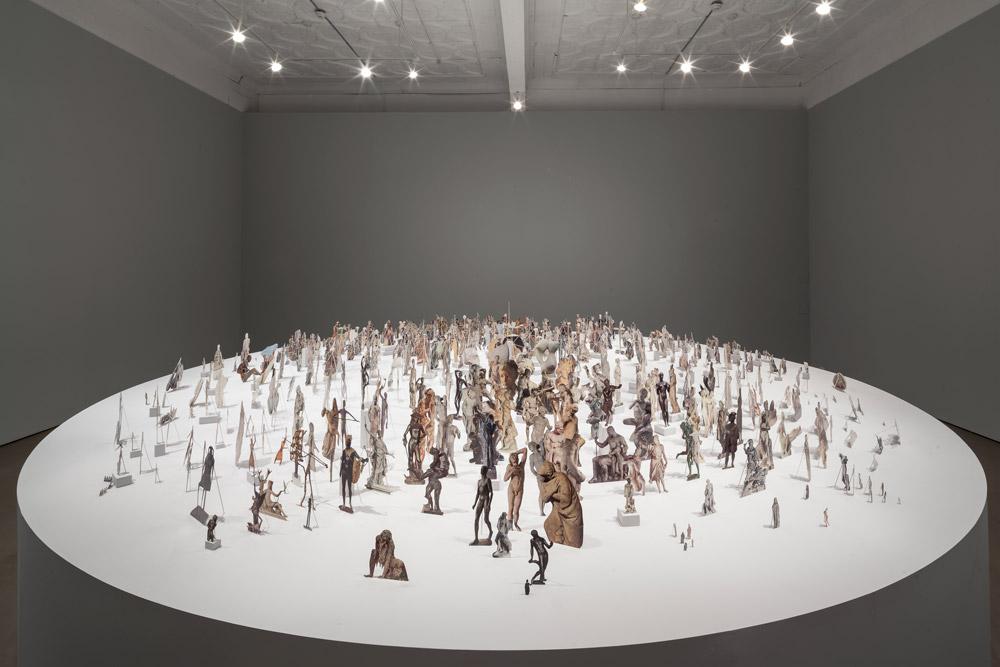“Janet Cardiff and George Bures Miller: Lost the Memory Palace” at the Art Gallery of Ontario, Toronto
It’s rare to be afforded travel within an art gallery, or better still, slippage. Perhaps this is even more true when one is working or interning at said gallery, as I was at the AGO during the run of this show. Yet despite my familiarity with the institution, these Cardiff and Miller works managed to push, pull and trip me into alternate spaces and slow time. The decision to present the works in darkened, discrete rooms evoked the premise of the memory palace, and for me, each immersive environment poked and prodded at pockets of personal memory, whether lived and imagined. The photographic slideshow and witty banter of Road Trip (2004) conjured endless hours in the backseat of an orange 1972 Westfalia traversing mountainous roads. Opera For a Small Room (2005) reminded me of my own crowded storage space, filled with the beautiful and dusty remnants of my life. But perhaps more than the stage-set-like constructions, it was the bare simplicity of their newest work Experiment in F# Minor (2013), a tabletop covered in upturned speakers, that was most captivating. Visitor shadows trigger individual speakers, resulting in a unique composition that is never the same twice. It’s striking when taken as an analogy for memory itself—it, too, being an echo of an event that continually fuses with neighbouring moments and can never be exactly reproduced.
Elena Filipovic lecture at the Urban Field Speaker Series, Toronto
In this March lecture at Toronto’s Prefix, Filipovic—curator at Wiels Contemporary Art Centre in Brussels—discussed the hows and whys of her curatorial approach to organizing a travelling multi-part retrospective for Felix Gonzales-Torres in 2010. She explained her difficulty in assembling a major overview exhibition—a type of show largely conceived to legitimize and aggrandize an artist’s practice—when the works and the artist did not lend themselves to such interpretations. Troubled by the apparent disconnect between institutional conventions and the ethos of Gonzales-Torres’s projects, Filipovic went so far as to refuse the assignment in its early stages. The resulting six-part exhibition, co-curated by artists Danh Vo at Wiels, Carol Bove at Basel’s Fondation Beyeler, and Tino Sehgal at Frankfurt’s Museum für Moderne Kunst, was ambitious, experimental and inspiring. The takeaway from Filipovic’s lecture was the need for a responsive approach to curating—that is, taking cues from the work before developing an exhibition’s form, and welcoming risk as a fundamental aspect of exhibition-making. At a time when the term “curate” has been so vastly appropriated and applied, her talk (available for viewing online) was a strong reminder of the discipline’s capacity for rigour and provocation.
“Geoffrey Farmer: A Light in the Moon” at Mercer Union, Toronto
My favourite exhibition of the year is also the most recent one on this list. In Geoffrey Farmer’s deft hands, paper, photographs and sound have been transformed into a microcosmic capture of the beauty and fleeting presence of human history. The experience of viewing Farmer’s large sculpture Boneyard (2013) and unpredictable, computer-generated projection/film Look in my face; my name is Might-have-been; I am also called No-more, Too-late, Farewell (2013) is all the more surprising given their clean and minimal installation. The artist draws from a vast pool of references including Proust, biblical narrative, Brancusi and the pyramids to produce an arresting viewing experience that is simultaneously playful and stupefying in its encyclopedic breadth. In a similar vein to Cardiff and Miller, Farmer creates spaces for the personal within the universal. The lack of contextual material and text forces viewers to mine their own experiences to produce meaningful associations alongside those happenstance connections that Farmer sets up. Well worth a look (or a few looks) before it closes on January 11 of the new year.
Britt Gallpen is Canadian Art‘s web intern.









